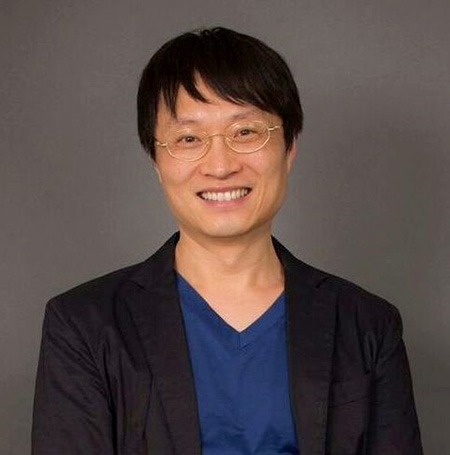Former Composer in Residence Featured in Concert and New York Times Review
San Diego, November 16, 2016 — Former Qualcomm Institute Composer in Residence Lei Liang is getting high marks from the New York Times ahead of his Nov. 17 concert at Columbia University's Miller Theatre in New York as he presents his newest work, "Lakescape V". The concert is part of the Composer Portraits series dedicated to leading composers of new music.

A professor of Music at UC San Diego, Liang is not the only Music faculty participating in the world premiere. Conductor Steven Schick and contrabassist Mark Dresser are also professors on the UC San Diego Music faculty. In addition to "Lakescape V", Liang's concert program includes the New York premiere of "Luminous" (2014), "Ascension" (2008), and "Serashi Fragments" (2005). Miller Theatre Executive Director Melissa Smey stated, “Lei Liang is one of the most celebrated voices in contemporary music, and it’s exciting to feature him in our Composer Portraits series.”
Liang’s concert, according to program notes, explores opposing forces while uniting “light and dark, paradise and inferno.” He composed “Lakescape V” for the loadbang ensemble, for trumpet, trombone, bass clarinet and baritone voice. The New York Times described a recent rehearsal and said that the opening section has “an effect like the passing of granular hail through funnel clouds.”
Liang, 43, has received numerous honors including a 2015 Koussevitzky Foundation grant, the 2011 Elliott Carter Rome Prize, a 2009 Guggenheim Fellowship and a 2008 Aaron Copland Award. His saxophone concerto “Xiaoxiang” was a finalist for the Pulitzer Prize in Music in 2015. His new CD, “Luminous”, is due for release next month and includes five recent compositions. It features UC San Diego music faculty members Schick and Dresser, as well as Aleck Karis, Erik Carlson and others.
Born in Tianjin, China, where he attended class not far from the Tiananmen Square protests, Liang came to the U.S. as a high school student. He earned degrees from the New England Conservatory of Music (B.M. and M.M.) and Harvard University (Ph.D.) and has studied composition with contemporary composers such as Sir Harrison Birtwistle, Robert Cogan, Chaya Czernowin, Mario Davidovsky and many others.

Liang joined UC San Diego’s music faculty in 2007, and became Composer in Residence at UC San Diego's interdisciplinary Qualcomm Institute in 2013 through earlier this year.
Ahead of today's concert, Liang was the subject of a flattering portrait in the Music section of the New York Times, titled "For Composer Lei Liang, Technology Brings a Different Transcendance." Writing Lara Pellegrinelli notes that "Lakescape V" displays Liang's emphasis on storytelling that almost won him a Pulitzer Prize in 2015 for the saxophone concerto "Xiaoxiang", which "was inspired by the tale of a villager whose husband was killed by a Communist official during the Cultural Revolution." She goes on to report that "the technology that Mr. Liang encountered during a three-year residency from 2013-2016 at the California Institute for Telecommunications and Information Technology's Qualcomm Institute fundamentally shifted his perception of space."
"Think of it like a bird that can fly into a painting, like the animated perspective of a drone," Liang explained to the writer to describe his new style. "You can look at something very closely -- or pull away. You can create swift transitions between what you choose to see." It was at the Qualcomm Institute that Liang developed "Hearing Landscapes" (2015), working with a team of engineers led by Prof. Falko Kuester, whose robotic imager scanned paintings by the Chinese artist Huang Binhong, "a master at creating the illusion of depth."

The ultra-high-resolution images in excess of four billion pixels could fill 2,000 HD television displays at native resolution, giving the viewer a sense of penetrating two-dimensional surfaces, according to the Times, and being immersed in the painting as in virtual reality. "I felt like I was standing on a mountain," Liang is quoted as saying about the first time he saw one of the paintings projected on the Qualcomm Institute's 4K projection system.
The Department of Music resides within the Division of Arts and Humanities at UC San Diego. The division recently moved up 10 spots to #23 in the recent rankings by U.S. News & World Report’s Best Global Universities. The Department of Music was founded by innovative composers who shared a belief that the most effective educational environment brings together the finest faculty with gifted graduate students in a challenging, supportive environment that encourages each student to find his or her own path. Today, the Department of Music offers graduate degree programs in Composition, Computer Music, Integrative Studies and Performance. It offers undergraduate programs that satisfy a wide range of interests for both music and non-music majors.
Media Contacts
Doug Ramsey, QI (858) 822-5825, dramsey@ucsd.edu and Dirk Sutro, Arts & Humanities 858-534-4830, dsutro@ucsd.edu
Related Links
New York Times Nov. 15 Article
Qualcomm Institute
Miller Theatre Composer Portraits Series

